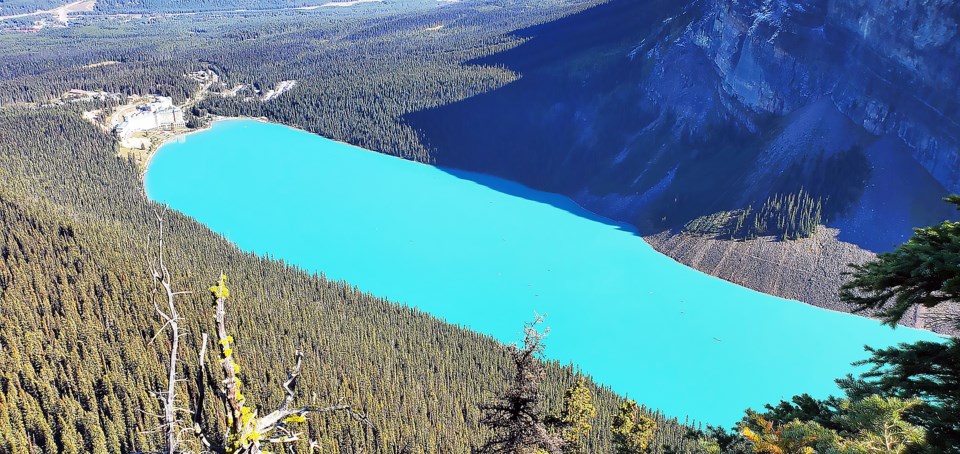Visitors to iconic Lake Louise can expect major traffic disruption and congestion chaos this summer due to a long overdue $9.8 million construction and re-paving project on Lake Louise Drive.
This is why Parks Canada is urging visitors now to plan ahead now to book a shuttle as an easy, stress-free way to see Lake Louise and Moraine Lake – two tourism hotspots in Banff National Park.
François Masse, superintendent for Lake Louise, Yoho and Kootenay, said a robust traffic management plan will be in place, particularly given the road sees about one million vehicles each summer.
“It’s going to be major impact to this coming tourist season and people are going to have to be a little patient,” he said during the 24th annual Banff National Park planning forum on Wednesday (Feb. 28).
“There’s no way you can do a project of this magnitude without having construction equipment and some disruption, but we’re going to do our best to minimize disruption,” he added.
“Even more so than previous years, people need to plan ahead and they need to be using the shuttles … that’s going to be the easiest way to get up there and the guaranteed way to get up.”
The redesign of Lake Louise Drive, which has seen traffic rise by roughly 70 per cent in the past 10 years, was announced in 2023 as part of a $71 million federal infrastructure funding initiative in Banff, Yoho, Kootenay and Jasper national parks.
Construction is expected to get underway as early as April, weather dependent.
Aside from much-needed repairs and re-paving of the pothole-ridden road, upgrades include a new roundabout at the intersection of Sentinel Road, Fairview Drive, and Lake Louise Drive, and a new access road into Fairview day-use area to improve traffic flow.
Additional pedestrian crossings, updated signage, road painting, lights, and arrows to improve pedestrian crossings and sharing of the road with cyclists are all part of the project design.
In addition, the work includes better traffic flow that connects St. Piran, Chateau Lake Louise and Upper Lake Louise parking, which also aims to improve pedestrian safety.
Officials say new traffic control measures and road design for a variety of transportation options will provide safer access and improved visitor experience.
“We will take the opportunity to improve fluidity of traffic and make sure that it’s designed with shuttles in mind from the get-go,” said Masse.
Tourism officials want to see planning work evolve to include more than just the functional requirements of updating public infrastructure, similar to the 2007 Banff Refreshing, a major construction project in the heart of the downtown shopping district on two blocks of Banff Avenue.
“There is a need to consider visitor experience as part of the project to help smooth out the impacts,” said Wanda Bogdane, executive director of Banff & Lake Louise Hospitality Association.
“We hope our visitors can be reached at multiple points before they arrive and through their trip experience to help set expectations and shape their impressions.”
One idea, said Bogdane, is the development of a robust proactive communications strategy that is built on the standards that Banff National Park is known for to maintain a welcoming guest experience. “Working with tourism partners can help shape this, along with a good dose of creativity,” she said.
Construction happens, Bogdane said, and as much as it is a part of community and destination management, this can be used as an opportunity to “inform and inspire” visitors.
“The project team can tell a story of our values, the outcomes anticipated, an invitation to come back to see the results, and a thank you for enduring as options to help elevate the experience of those affected while the work is being completed,” she said.
Last year, Parks Canada banned private vehicles to Moraine Lake year-round.
It is mandatory to take Parks Canada-run shuttles from a park-and-ride lot at the Lake Louise ski hill, Roam public transit, or commercial buses. Guests of Moraine Lake Lodge and individuals in vehicles displaying proper accessibility hang-tags are permitted to travel by private vehicle.
As for Lake Louise, the Parks Canada-struck expert panel on moving people sustainability throughout Banff National Park recommended banning private vehicles to Upper Lake Louise, combined with a robust transit system.
“There’s no plan to create new restrictions right now, but there are definitely plans to very actively manage the way that the traffic flows there,” said Masse.
“We have to be very careful of not backing traffic up on the highway.”
Masse said through the visitor use management plan for the area, Parks Canada is looking at capacity at Lake Louise and Moraine Lake.
“We are looking at what are the management tools that we can use to make sure we’re not exceeding that capacity, and that we’re giving people a good experience while there, even though it’s busy,” he said.
Lake Louise Drive cuts through the Fairview wildlife corridor, which is one of two critical wildlife corridors in Lake Louise used by wildlife to travel between areas to reproduce, feed and find shelter. The other is the Whitehorn corridor on the other side of the valley.
These corridors provide important movement pathways for wary wildlife in an area otherwise constrained by development and steep mountain terrain. They also provide core habitat for resident animals that may not travel far beyond the area.
The Lake Louise area is also part of a core reproductive range for grizzly bears, which are a threatened species in Alberta.



